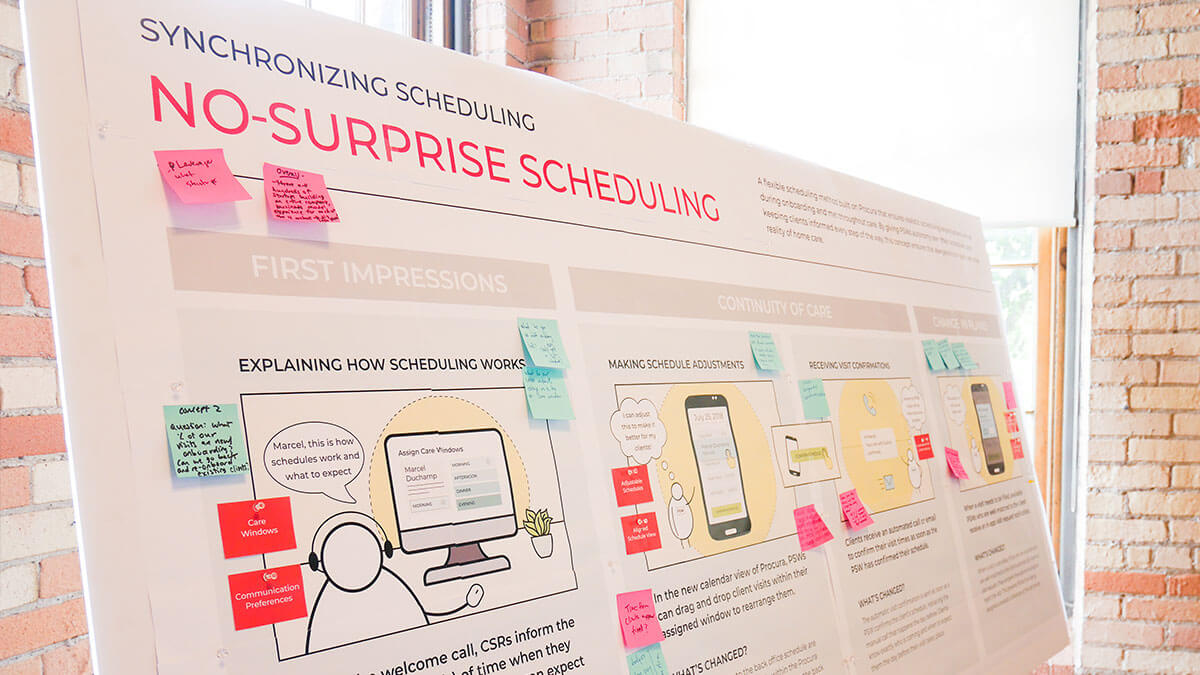
Ideas by Sinead Wickham
Doing home care differently: Five key strategies from service design
Author

- Sinead Wickham
- Manager, Design Strategy
Home care is a complex, necessary service grappling with limited funding and ever-increasing demand. Today, the home care model is mostly transactional, too often treating clients as “just a number” and PSWs (personal support workers) as replaceable. In part due to larger system constraints, this leaves service provider organizations low on resources, with overburdened staff and under-served clients. Service design is a people-centred approach to making sense of this mess and coming up with solutions to improve it.
Bridgeable partnered with SE Health, a Canadian home care provider, to take a service design approach to imagining what the future of home care could look like in suburban Ontario. Our method involved spending time in the field doing primary research, running stakeholder workshops, developing prototypes, and more. While the process was far from linear, it ultimately led us to create a holistic, end-to-end service experience for SE Health. As a bonus, we learned about the unique challenges the home care space faces and identified some valuable strategies for innovation.
Our partnership with SE Health demonstrated that home care starts and ends outside the home. Patient- and family-centred care can happen only when all stakeholders, from the back office to the front line, are in sync with each other. At Bridgeable, we know that a successful project requires input from these people, and our process places a premium on leveraging their expertise. It is vital that we listen to their experiences, share their stories, and seek out the common thread that unites them.
Our work in home care has helped us identify the following five key strategies for taking a more human service design approach to home care:
1. Look beyond organizational hierarchy
Finding a novel approach in a complicated space like home care requires listening to the perspectives of different people. Too often, traditional hierarchies keep strategic conversations stuck in the C-suite, working without input from client-facing staff. In home care, this tends to mean leaving out the frontline workers like PSWs.
Bridgeable’s service design approach acknowledges this bias and aims to bring in the voices of frontline staff at every phase of the project. Our work with SE Health involved going beyond interviews with PSWs and including them as part of the project team at design workshops and check-ins and through regular online correspondence. As home care experts, they were able to fact-check our work with on-the-ground, client-facing experience. For example, during a checkpoint in our project when the team was reviewing the experience map, a PSW in the group was quick to point out what we had missed: support staff are often the first people to meet clients, entering the home before a formal welcome visit can take place. This firsthand knowledge led us to explore client onboarding and visit preparation as new opportunity areas.
By giving frontline staff agency in the project, including a safe space in which to speak and be heard, and by heeding their advice, we gained tremendous insight. Making this relationship work required us to forge trust with the staff and, admittedly, involved some logistical strain (PSWs are busy people!). But in the long run, this relationship paid off by deepening our understanding of the context we were designing for.
2. Reduce uncertainty in times of change
Home care can bring big changes into a client’s life, often threatening their sense of privacy and autonomy. First impressions have a huge impact on how a client feels throughout care. Changes of plans, big or small, can cause anxiety because clients begin to feel they don’t know what lies ahead.
In service design, tools like experience maps can help identify those moments that are the most important to clients. These maps visualize the journey a client takes through engagement with a service, identifying the highs and lows they feel at each step. The experience map we created for SE Health revealed emotional lows during transition moments when clients had little awareness or access to information.
One moment that stood out in our map but that wasn’t being recognized at a service level was the first meeting between a PSW and their client. This moment is stressful for both people, as neither knows much about the other. By addressing this uncertainty, we were able to build out concepts that equip each actor with simple pre-visit information. When we tested these concepts in the field, users expressed appreciation for these changes, noting that although they were simple adjustments, they often had a big positive impact.
In service design, tools like experience maps can help identify those moments that are the most important to clients.
3. Pay attention to workarounds
People tend to make up for service shortcomings by designing their own solutions—often referred to as “workarounds”—based on personal experience and tacit knowledge. While big problems are easy to identify, we tend to overlook these informal strategies that are already in use. One way to uncover workarounds is to simply watch staff do their work. Looking for processes they follow and tools they use can reveal hidden problems and help identify possible solutions.
When our team shadowed PSWs, we were able to see into clients’ homes, where home care services are delivered. Through active observation, we discovered personal solutions developed by caregivers and PSWs to improve the quality of the care being provided. These workarounds were simple ways to compensate for needs that were not being met: repeated notes posted by caregivers for visit-specific information sharing and daily scheduling adjustments by PSWs to better sync schedules with their routines and to accommodate unexpected client needs.
As part of the service strategy we developed for SE Health, our team included both PSW and caregiver workarounds in our prototypes. In a sense, this turned our observation into a co-design activity that might benefit any complex project. The lesson we took away was to watch for the little things that people are doing to make systems work for them. Pay attention to the ways that they use their experiential knowledge to deviate from a set process and watch how these changes improve services for themselves and others.

4. Build consensus with storytelling
Storytelling tools like experience maps, service blueprints, booklets, and storyboards are all artifacts that help make sense of research findings. They help teams develop understanding, and they create opportunities for stakeholders to provide input. However, these are often treated as internal process documents for the project team and are not shared with a larger group until final presentations. To make the most of them, design artifacts should be shared at multiple project stages as a means to socialize the work and align stakeholder understanding. Showing your work while it’s still in progress can help generate early buy-in from relevant people and create allies for future stages.
Storytelling tools can be used individually or together as part of a project narrative. This summer, toward the end of our research phase, Bridgeable hosted a synthesis workshop for the project team and stakeholders. In preparation for this meeting, we created a research workbook to share and collect feedback, outlined our findings in an experience map and task flow diagrams, and designed a short takeaway booklet that summarized our work until that point. Throughout the workshop, participants used the research workbook, map, and diagrams as concrete reference artifacts to call out specific data points and give definitive feedback. As they returned to work, we provided them with copies of the takeaway booklet to share with their colleagues. This enabled people who couldn’t attend the session to learn about the project and bring themselves up to date on our work.
Design artifacts are about sharing your work with subject matter experts and people who can make change. The best way to keep your project accurate, client-facing, and user-centered is to include relevant people at every stage and use creative tools to help them engage with your work.
5. Break implementation into easy steps
Healthcare and public sector fields can feel slow-moving because it takes a lot of diligent work to create solutions that address system needs and constraints. When proposing a new service that might require a lot of legwork, giving people small steps that they can take today will ensure that your proposal becomes a reality in the long run.
In the context of our project with SE Health, this meant creating solutions that were flexible and built around the organization’s existing capabilities. Designing it as an end-to-end experience, we broke our proposed strategy into three concepts, each made up of smaller features and prototypes. These small features work like puzzle pieces that can be implemented alone and built up to the big-picture service strategy over time. To make this clear, Bridgeable created an implementation guide and service blueprint to help key actors understand the solution as it relates to the client experience and their day-to-day jobs. These included simple instructions for pilot and scale-up phases and called out the key partners required.
The broader takeaway, however, is that this approach can generate novel insights in any project. Design is collaborative and explorative and should always be practical.
Thanks to our step-by-step solution, SE Health was able to get started building some of the smaller features right away. They quickly identified which parts of the proposed service align with current funding strategies and which parts could inform or be added on to existing projects. The key to this fast action is to provide people with easy steps and a neat map of the solution with clearly identified roles. Think about what can be done in six months, and empower key actors to kick-start a project without becoming overwhelmed.
Whether or not you’re a designer by trade, these lessons are about bringing a more human approach to home care, and even healthcare more generally. On this project, using service design methodology revealed that home care is a complicated experience starting and ending outside the home. The broader takeaway, however, is that this approach can generate novel insights in any project. Design is collaborative and explorative and should always be practical.
Engaging with stakeholders beyond a superficial level and leveraging tools and activities that involve them in the process at every phase is the key to creating outcomes that have impact in the real world.

Sinead Wickham
Manager, Design Strategy